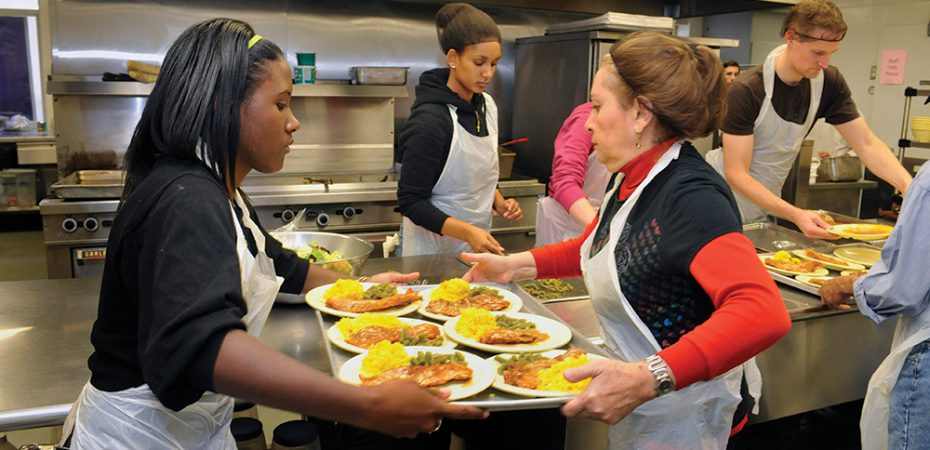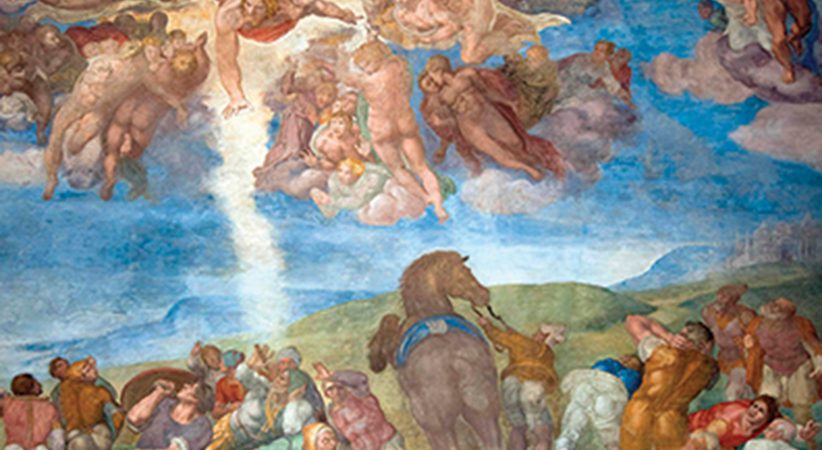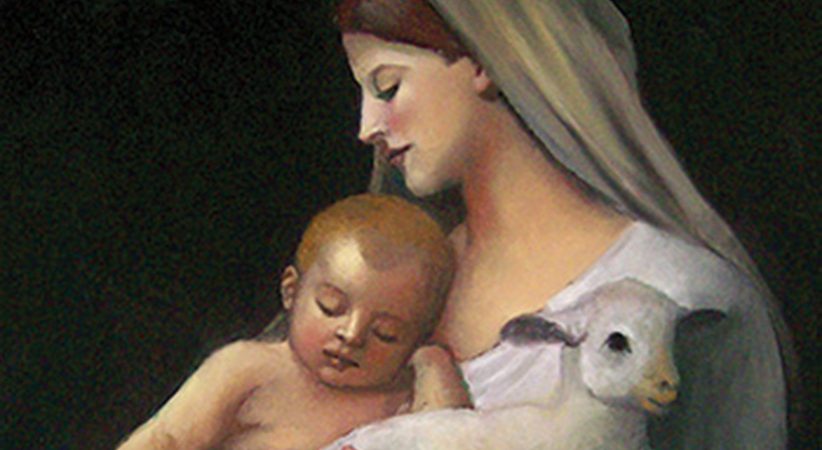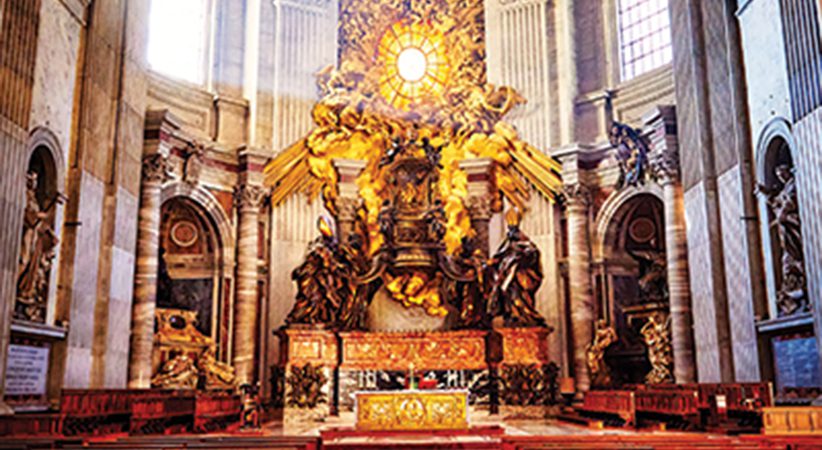Thanksgiving at the Parish
How to take a secular holiday and make it holy
Paul Senz Comments Off on Thanksgiving at the Parish
Life in a Catholic parish certainly has many challenges and blessings. For parish priests, one particular and very specific challenge arises a few times a year: How do you celebrate Mass for a particular day when the day is primarily focused on a secular or national holiday?

Think of the Fourth of July. Think of Veterans Day. Think of Memorial Day. And perhaps the chief example: Thanksgiving. The priest is given the task of walking a tightrope between focusing too much on the nonliturgical significance of the day, while at the same time not neglecting the reason most people may be attending Mass that day.
Thanksgiving is a particularly interesting example.
The Thanksgiving holiday is one of the quintessential American holidays, right up there with the Fourth of July. In 1621, the earliest days of European settlement of the American continent, pilgrims from the Mayflower landed at Plymouth and worked to set up a village. It was a brutal winter, and many of the pilgrims remained on the ship in horrible conditions. Only half of them lived through to the spring.
When they all moved ashore, they were met by an Indian speaking English and were astonished. A few days later they met Squanto. Squanto had been enslaved by the English (where he had learned the language), and freed by Spanish Franciscans. The Franciscans catechized him in the Catholic Faith and baptized him. He taught the pilgrims how to grow corn and catch fish, and he showed them which plants to avoid. He helped them make peace with the local natives.
‘First’ Thanksgiving
The pilgrims were not Catholic. But the intimate involvement of Squanto brings a Catholic element to this “first Thanksgiving.” The pilgrims and the Wampanoag Native Americans shared a harvest feast to celebrate the first successful corn harvest. This is considered one of the first Thanksgiving celebrations in the nascent colonies.
The first Thanksgiving in what would later become the United States was on Sept. 8, 1565, in St. Augustine, Florida. Native Americans and Spanish settlers gathered together for a feast and Mass. There was a similar day of thanksgiving, with Mass and a feast, on April 30, 1598, in Texas. These days of thanksgiving, which included the Mass, truly embody the Catholic spirit of thanksgiving: Eucharistia.
As the reader will likely know, our word Eucharist derives from the Greek Eucharistia, which means “thanksgiving.” In the current English translation of the Roman Missal, Eucharistic Prayer 3 contains the line, “Therefore, O Lord, we celebrate the memorial of the saving Passion of your Son, his wondrous Resurrection and Ascension into heaven, and as we look forward to his second coming, we offer you in thanksgiving this holy and living sacrifice.” This is the crux of the matter, the sacrifice of the Cross offered in perpetuity in thanksgiving for our salvation through Jesus Christ.
We are called to acknowledge our blessings, and to give thanks to God for the graces he has bestowed upon us. The Eucharist is the height of thanksgiving, and the source and summit of the life of the Church.
As the decades and centuries passed, days of thanksgiving became more common in the colonies, and later in the states. George Washington issued the first Thanksgiving proclamation by the federal government in 1789. Individual colonies and states observed their own days of thanksgiving for decades, until 1863 when President Abraham Lincoln proclaimed that a national day of Thanksgiving would be held each November. This was in the midst of the Civil War, a time when the nation could really be served by focusing on what we have to be thankful for.
In our nation and our Church, we are going through some difficult times. This year, why not take the opportunity to emphasize the importance of giving thanks and recognizing our blessings around the Thanksgiving holiday.
Uniquely Catholic
Parishes can take advantage of the Thanksgiving holiday, and even commemorate the day in a uniquely Catholic way, in many ways. First and foremost, with Mass. Set it for a special time and encourage parishioners to attend during weekend Masses. Put an announcement in the bulletin. If the parish has a reader board or an electronic sign, put the information there, as well. There is no greater way to celebrate the Thanksgiving holiday than to celebrate Mass.
St. John Marie Vianney famously said: “There is nothing so great as the Eucharist. If God had something more precious, he would have given it to us.” The Eucharist should always be before us and should be the way we mark important events and days throughout our lives.
In the weeks leading up to the holiday, the parish can collect food to distribute to those in need. Encourage parishioners to donate food or to contribute money to a fund that can be used to feed the hungry and clothe the naked. If the parish has the means and ability, a soup kitchen can be an effective way to reach out to the needy in the community, and it can be an opportunity for parishioners to do something practical to help those in need.
Every parish is different, and the needs of the parish, as well as the needs of the local community, make a big difference as to how the parish will commemorate the day.
Learning from others
A simple internet search illustrates how parishes across the country are marking Thanksgiving. Each parish celebrates the holiday in its own way. At each parish, the primary activity of the day is the Mass, but there are many variations on the activity for the rest of the day. Here are several examples:
Emmaus Catholic Parish, Austin, Texas: Each year the parish hosts a Community Thanksgiving Meal, where anyone is welcome. There is no cost. The aim, according to the parish’s website, is “bringing together the people of our community with fellowship and a meal.”
St. Philip Neri Catholic Church, Portland, Oregon: The parish has an annual Thanksgiving Day Meal, which is open to parishioners and those “neighbors who are alone, without plans, or are homeless or in transition.” The parish also collects donations of gloves, scarves, socks, coats and blankets to be distributed to those in need.
St. Ambrose Catholic Parish in Brunswick, Ohio: Their Thanksgiving Day Community Meal provides around 7,500 meals throughout the Akron and Cleveland areas. “It’s one more example of the good we do together for the Lord and those in need,” it says on the parish website. “Together we are bringing the care and compassion of Christ to our community and those in need.”
St. Stephen Protomartyr Catholic Church, St. Louis, Missouri: Their “Turkey Bowl” is an annual soccer game between eighth graders and their parents.
Corpus Christi, Aliso Viejo, California: Every year they host a Thanksgiving Dinner; 2018 was the 20th year for this tradition, and the parish hosted 20 United States Marines for the dinner, giving parishioners an opportunity to show their thanks to servicemen.
St. Rose of Lima Catholic Church, Gaithersburg, Maryland: A Thanksgiving Day Mass is held to “give thanks in a special way for God’s many blessings.” Congregants are encouraged to bring food that will be served at their own Thanksgiving meals to be blessed.
St. Joseph Catholic Church, Fort Collins, Colorado: The pastor and parish staff shared family recipes with the parish.
St. Joseph Catholic Church,St. Charles, Missouri: The St. Vincent de Paul Society collects frozen turkeys to be distributed to those who cannot afford a turkey for their meal.
St. Francis Borgia, Blair, Nebraska: The parish hosts an annual Community Thanksgiving Dinner, with around 900 people in attendance. Their aim is to reach out to people who have no one else to share the holiday with.
St. Monica, Santa Monica, California: Annual Thanksgiving Dinner and Clothing Boutique, held the day before Thanksgiving. This event is free. Following the family-style dinner is a boutique with free items of clothing, blankets, sleeping bags and toiletries.
Throughout the nation, parishes mark Thanksgiving in their own way. Parishes can always learn from one another and even adjust ideas to their own community’s needs.
After Meal Prayer
Thanksgiving is an opportunity to encourage prayer of thanksgiving in parishioners’ personal lives. When I was a student at Visitation Catholic School in the Dutch-Catholic enclave of Verboort, Oregon, every day after lunch the students recited this prayer:
“We give thee thanks for all thy benefits, Almighty God, who lives and reigns forever. And may the souls of the faithful departed, through the mercy of God, rest in peace. Amen.”
Ending the meal with thanks for the bounty that the Lord has bestowed upon us brings home the thankfulness we should have for God’s blessings. This mindfulness is particularly appropriate around Thanksgiving.
There are many ways that Catholic parishes can commemorate Thanksgiving. Above all, we must remember to be grateful to God for all of his blessings.
Paul Senz writes from Oregon.
…………………………………………………………………………………………………………………………………………………….
Prayer of Thanksgiving
“Thanksgiving characterizes the prayer of the Church which, in celebrating the Eucharist, reveals and becomes more fully what she is. Indeed, in the work of salvation, Christ sets creation free from sin and death to consecrate it anew and make it return to the Father, for his glory. The thanksgiving of the members of the Body participates in that of their Head.”
“As in the prayer of petition, every event and need can become an offering of thanksgiving. The letters of St. Paul often begin and end with thanksgiving, and the Lord Jesus is always present in it: ‘Give thanks in all circumstances; for this is the will of God in Christ Jesus for you’; ‘Continue steadfastly in prayer, being watchful in it with thanksgiving.’” — Catechism of the Catholic Church, Nos. 2637-38.
………………………………………………………………………………………………………………………………………………………





